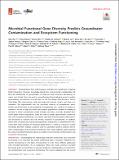| dc.contributor.author | He, Zhili | |
| dc.contributor.author | Zhang, Ping | |
| dc.contributor.author | Wu, Linwei | |
| dc.contributor.author | Rocha, Andrea M. | |
| dc.contributor.author | Tu, Qichao | |
| dc.contributor.author | Shi, Zhou | |
| dc.contributor.author | Wu, Bo | |
| dc.contributor.author | Qin, Yujia | |
| dc.contributor.author | Wang, Jianjun | |
| dc.contributor.author | Yan, Qingyun | |
| dc.contributor.author | Curtis, Daniel | |
| dc.contributor.author | Ning, Daliang | |
| dc.contributor.author | Van Nostrand, Joy D. | |
| dc.contributor.author | Wu, Liyou | |
| dc.contributor.author | Yang, Yunfeng | |
| dc.contributor.author | Elias, Dwayne A. | |
| dc.contributor.author | Watson, David B. | |
| dc.contributor.author | Adams, Michael W. W. | |
| dc.contributor.author | Fields, Matthew W. | |
| dc.contributor.author | Hazen, Terry C. | |
| dc.contributor.author | Adams, Paul D. | |
| dc.contributor.author | Arkin, Adam P. | |
| dc.contributor.author | Zhou, Jizhong | |
| dc.contributor.author | Alm, Eric J | |
| dc.date.accessioned | 2018-08-24T18:09:37Z | |
| dc.date.available | 2018-08-24T18:09:37Z | |
| dc.date.issued | 2018-02 | |
| dc.date.submitted | 2018-01 | |
| dc.identifier.issn | 2150-7511 | |
| dc.identifier.uri | http://hdl.handle.net/1721.1/117516 | |
| dc.description.abstract | Contamination from anthropogenic activities has significantly impacted Earth’s biosphere. However, knowledge about how environmental contamination affects the biodiversity of groundwater microbiomes and ecosystem functioning remains very limited. Here, we used a comprehensive functional gene array to analyze groundwater microbiomes from 69 wells at the Oak Ridge Field Research Center (Oak Ridge, TN), representing a wide pH range and uranium, nitrate, and other contaminants. We hypothesized that the functional diversity of groundwater microbiomes would decrease as environmental contamination (e.g., uranium or nitrate) increased or at low or high pH, while some specific populations capable of utilizing or resistant to those contaminants would increase, and thus, such key microbial functional genes and/or populations could be used to predict groundwater contamination and ecosystem functioning. Our results indicated that functional richness/diversity decreased as uranium (but not nitrate) increased in groundwater. In addition, about 5.9% of specific key functional populations targeted by a comprehensive functional gene array (GeoChip 5) increased significantly (P < 0.05) as uranium or nitrate increased, and their changes could be used to successfully predict uranium and nitrate contamination and ecosystem functioning. This study indicates great potential for using microbial functional genes to predict environmental contamination and ecosystem functioning. IMPORTANCE Disentangling the relationships between biodiversity and ecosystem functioning is an important but poorly understood topic in ecology. Predicting ecosystem functioning on the basis of biodiversity is even more difficult, particularly with microbial biomarkers. As an exploratory effort, this study used key microbial functional genes as biomarkers to provide predictive understanding of environmental contamination and ecosystem functioning. The results indicated that the overall functional gene richness/diversity decreased as uranium increased in groundwater, while specific key microbial guilds increased significantly as uranium or nitrate increased. These key microbial functional genes could be used to successfully predict environmental contamination and ecosystem functioning. This study represents a significant advance in using functional gene markers to predict the spatial distribution of environmental contaminants and ecosystem functioning toward predictive microbial ecology, which is an ultimate goal of microbial ecology. | en_US |
| dc.publisher | American Society for Microbiology | en_US |
| dc.relation.isversionof | http://dx.doi.org/10.1128/MBIO.02435-17 | en_US |
| dc.rights | Creative Commons Attribution 4.0 International License | en_US |
| dc.rights.uri | http://creativecommons.org/licenses/by/4.0/ | en_US |
| dc.source | American Society for Microbiology | en_US |
| dc.title | Microbial Functional Gene Diversity Predicts Groundwater Contamination and Ecosystem Functioning | en_US |
| dc.type | Article | en_US |
| dc.identifier.citation | He, Zhili et al. “Microbial Functional Gene Diversity Predicts Groundwater Contamination and Ecosystem Functioning.” Edited by Jennifer Martiny. mBio 9, 1 (February 2018): e02435 © 2018 He et al. | en_US |
| dc.contributor.department | Massachusetts Institute of Technology. Department of Biological Engineering | en_US |
| dc.contributor.mitauthor | Alm, Eric J | |
| dc.relation.journal | mBio | en_US |
| dc.eprint.version | Final published version | en_US |
| dc.type.uri | http://purl.org/eprint/type/JournalArticle | en_US |
| eprint.status | http://purl.org/eprint/status/PeerReviewed | en_US |
| dc.date.updated | 2018-08-23T14:48:30Z | |
| dspace.orderedauthors | He, Zhili; Zhang, Ping; Wu, Linwei; Rocha, Andrea M.; Tu, Qichao; Shi, Zhou; Wu, Bo; Qin, Yujia; Wang, Jianjun; Yan, Qingyun; Curtis, Daniel; Ning, Daliang; Van Nostrand, Joy D.; Wu, Liyou; Yang, Yunfeng; Elias, Dwayne A.; Watson, David B.; Adams, Michael W. W.; Fields, Matthew W.; Alm, Eric J.; Hazen, Terry C.; Adams, Paul D.; Arkin, Adam P.; Zhou, Jizhong | en_US |
| dspace.embargo.terms | N | en_US |
| dc.identifier.orcid | https://orcid.org/0000-0001-8294-9364 | |
| mit.license | PUBLISHER_CC | en_US |
